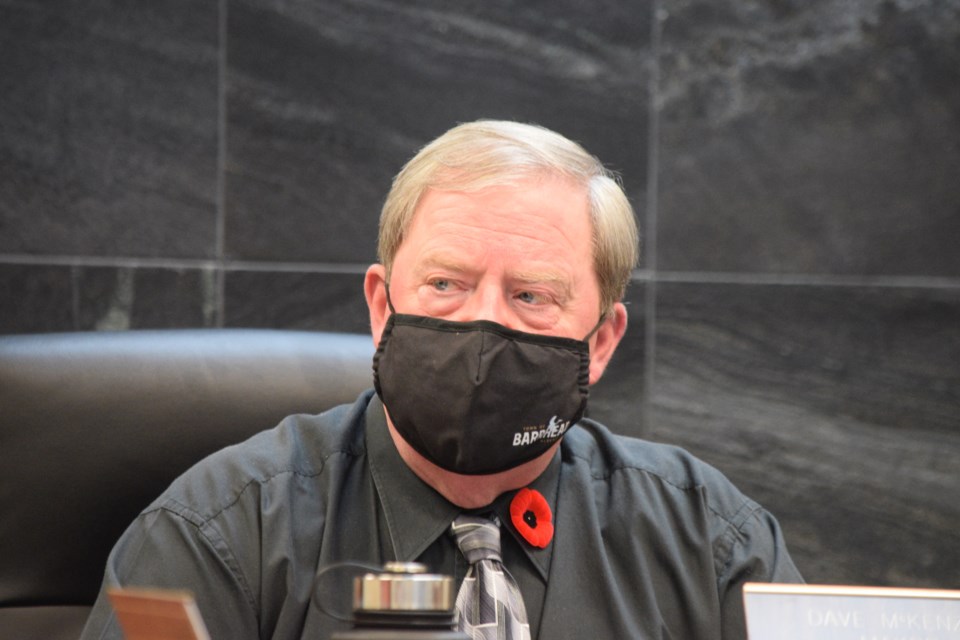BARRHEAD-There isn't much the Town of Barrhead can do to change the commuter patterns of commercial trucking on the highways that pass through the community.
That was mayor Dave McKenzie's response to Coun. Ty Assaf suggested that they change the town's Traffic Bylaw to reduce the risk of a motor vehicle collision at the intersection of Highway 18 and 33.
On Nov. 2, there was an accident involving a logging truck and a Pembina Hills School Division (PHSD) school bus — where multiple logs came dislodged while the truck was turning right onto Highway 18 from Highway 33 impaling a school bus waiting at the lights.
Fortunately, there were no serious injuries.
"I understand that the province and Alberta Transportation has jurisdiction over highways," he said. "But is there no way that the municipality could impose a timeline on when they travel through town?"
He added it is his understanding large commercial trucks have to "plan and submit their route for approval."
Assaf asked to have the topic added to the agenda of the Nov. 9, council meeting.
Mayor Dave McKenzie replied that all commercial vehicles have operating authorities.
"It is a provincial requirement. In those operating authorities, particularly for oversized or over-dimensional loads, the routes they have to take and the times they can operate are laid out," he said, adding sometimes the window is only three or four hours.
McKenzie is a retired RCMP officer and spent nine years as a traffic consultant with Alberta Transportation.
He added any changes to that route would have to come from Alberta Transportation.
"We have no jurisdiction on highways. "We could pass a bylaw saying (large trucks) can't operate here," McKenzie clarified. "But it would be superseded by any provincial statutes."
He also noted that during his time with Alberta Transportation, the department was reluctant to grant any request from a municipality that might "slow down commerce."
"Even if it was a request by a municipality to reduce the speed on a highway, even if it just went past them, the province would say that they would receive push back from the trucking lobby," McKenzie said. "Anytime a trucker has to gear down from 110 kilometres an hour to 80 or 60, it costs them money."
However, he said council can be rest assured that Alberta Transportation is looking into the incident with a fine-tooth comb, going over the "survey and measurements" along with other data.
"You say the word schoolbus and collision and it rings all sorts of bells at Alberta Transportation," McKenzie said.
However, Alberta Transportation Minister Rajan Sawhney, in a Nov. 4 interview with the Barrhead Leader, said the circumstances the accident and the lack of other incidents occurring at that intersection would likely not trigger a review by the province.
“I would almost characterize it as a freak accident,” she said, adding that the RCMP investigation has determined there were some errors made by the driver who had over-loaded the truck.
Ultimately, McKenzie believes the intersection is safe and that the accident's cause was driver error.
The driver of the logging truck faces charges for the vehicle being overweight and improperly loaded.
"In reality, the intersection is pretty safe. We do have some accidents there, but they are rare," McKenzie said, admitting that the intersection does see its fair share of large vehicles, commercial and otherwise.
He noted the size of agricultural equipment that routinely use the two highways.
"Where do you draw the line? Anyone of those vehicles could have a catastrophic failure, resulting in a collision," McKenzie said. "You look at the multi-wing cultivators and air seeders that come around that corner ... if a safety chain or hydraulics fail, they can take out a whole street of vehicles."
He said the question is whether to change the "rules and spectrum around that intersection for what is essentially a one-off incident?"
McKenzie noted the safety of any intersection boils down to three components — engineering, enforcement and education — suggesting enforcement and education were the key components to making the intersection safer.
Coun. Rod Klumph suggested that if the municipality could not impose a truck route or other measure, perhaps they should lobby the province for a ring road to bypass the town.
McKenzie said there would be considerable opposition from the business community if the municipality proposed such a plan.
He added that if a bypass did come to pass, large commercial vehicles would not be the only ones that used it.
Coun. Dausen Kluin asked McKenzie if he thought the province would consider a truck route instead.
Instead of turning at two Two Mile Corner, he suggested that trucks could use Range Road 32 to what is commonly known as Manola Road (Township 594), eliminating the need to make a tight turn onto the highway.
Before that could happen, Manola Road would need to be upgraded, Klumph replied.
Coun. Anthony Oswald added it would not solve the problem, only move it.
"Even if we asked them to reroute to the north, they still have a hard turn at the cemetery," he said. "A large vehicle could hit a school bus, a fuel tanker, or anything else."
McKenzie added that although the municipality had the authority to create a transportation cooridor, they could only do so for municipal roads and not highways.
Barry Kerton, TownandCountryToday.com



